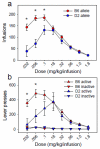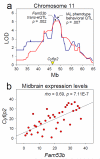Systems genetics of intravenous cocaine self-administration in the BXD recombinant inbred mouse panel
- PMID: 26581503
- PMCID: PMC4803082
- DOI: 10.1007/s00213-015-4147-z
Systems genetics of intravenous cocaine self-administration in the BXD recombinant inbred mouse panel
Abstract
Rationale: Cocaine addiction is a major public health problem with a substantial genetic basis for which the biological mechanisms remain largely unknown. Systems genetics is a powerful method for discovering novel mechanisms underlying complex traits, and intravenous drug self-administration (IVSA) is the gold standard for assessing volitional drug use in preclinical studies. We have integrated these approaches to identify novel genes and networks underlying cocaine use in mice.
Methods: Mice from 39 BXD strains acquired cocaine IVSA (0.56 mg/kg/infusion). Mice from 29 BXD strains completed a full dose-response curve (0.032-1.8 mg/kg/infusion). We identified independent genetic correlations between cocaine IVSA and measures of environmental exploration and cocaine sensitization. We identified genome-wide significant quantitative trait loci (QTL) on chromosomes 7 and 11 associated with shifts in the dose-response curve and on chromosome 16 associated with sessions to acquire cocaine IVSA. Using publicly available gene expression data from the nucleus accumbens, midbrain, and prefrontal cortex of drug-naïve mice, we identified Aplp1 and Cyfip2 as positional candidates underlying the behavioral QTL on chromosomes 7 and 11, respectively. A genome-wide significant trans-eQTL linking Fam53b (a GWAS candidate for human cocaine dependence) on chromosome 7 to the cocaine IVSA behavioral QTL on chromosome 11 was identified in the midbrain; Fam53b and Cyfip2 were co-expressed genome-wide significantly in the midbrain. This finding indicates that cocaine IVSA studies using mice can identify genes involved in human cocaine use.
Conclusions: These data provide novel candidate genes underlying cocaine IVSA in mice and suggest mechanisms driving human cocaine use.
Keywords: Addiction; Aplp1; Cocaine sensitization; Cyfip2; Fam53b; Genetic correlation; Light dark box; Open field; QTL; eQTL.
Figures







Similar articles
-
Extreme phenotypic diversity in operant response to intravenous cocaine or saline infusion in the hybrid mouse diversity panel.Addict Biol. 2022 May;27(3):e13162. doi: 10.1111/adb.13162. Addict Biol. 2022. PMID: 35470554 Free PMC article.
-
Association of novelty-related behaviors and intravenous cocaine self-administration in Diversity Outbred mice.Psychopharmacology (Berl). 2015 Mar;232(6):1011-24. doi: 10.1007/s00213-014-3737-5. Epub 2014 Sep 20. Psychopharmacology (Berl). 2015. PMID: 25238945 Free PMC article.
-
Quantitative-trait loci analysis of cocaine-related behaviours and neurochemistry.Pharmacogenetics. 1999 Oct;9(5):607-17. Pharmacogenetics. 1999. PMID: 10591541
-
Systems genetics: a paradigm to improve discovery of candidate genes and mechanisms underlying complex traits.Plant Sci. 2014 Jun;223:45-8. doi: 10.1016/j.plantsci.2014.03.003. Epub 2014 Mar 13. Plant Sci. 2014. PMID: 24767114 Review.
-
Systems genetics analysis of iron regulation in the brain.Biochimie. 2009 Oct;91(10):1255-9. doi: 10.1016/j.biochi.2009.04.009. Epub 2009 Apr 22. Biochimie. 2009. PMID: 19393285 Free PMC article. Review.
Cited by
-
5' UTR variants in the quantitative trait gene Hnrnph1 support reduced 5' UTR usage and hnRNP H protein as a molecular mechanism underlying reduced methamphetamine sensitivity.FASEB J. 2020 Jul;34(7):9223-9244. doi: 10.1096/fj.202000092R. Epub 2020 May 13. FASEB J. 2020. PMID: 32401417 Free PMC article.
-
Powerful, efficient QTL mapping in Drosophila melanogaster using bulked phenotyping and pooled sequencing.Genetics. 2022 Mar 3;220(3):iyab238. doi: 10.1093/genetics/iyab238. Genetics. 2022. PMID: 35100395 Free PMC article.
-
Do gene expression findings from mouse models of cocaine use recapitulate human cocaine use disorder in reward circuitry?Genes Brain Behav. 2021 Feb;20(2):e12689. doi: 10.1111/gbb.12689. Epub 2020 Sep 15. Genes Brain Behav. 2021. PMID: 32720468 Free PMC article.
-
Effects of isolation housing stress and mouse strain on intravenous cocaine self-administration, sensory stimulus self-administration, and reward preference.Sci Rep. 2023 Feb 16;13(1):2810. doi: 10.1038/s41598-023-29579-9. Sci Rep. 2023. PMID: 36797314 Free PMC article.
-
Extreme phenotypic diversity in operant response to intravenous cocaine or saline infusion in the hybrid mouse diversity panel.Addict Biol. 2022 May;27(3):e13162. doi: 10.1111/adb.13162. Addict Biol. 2022. PMID: 35470554 Free PMC article.
References
-
- American Psychiatric Association . Diagnostic and statistical manual of mental disorders. Revised 4th ed. Author; Washington, DC: 2000.
Publication types
MeSH terms
Substances
Grants and funding
LinkOut - more resources
Full Text Sources
Other Literature Sources
Medical
Molecular Biology Databases
Miscellaneous

